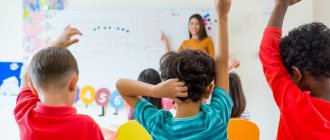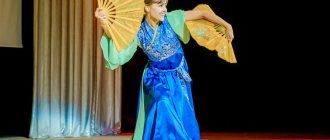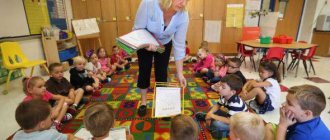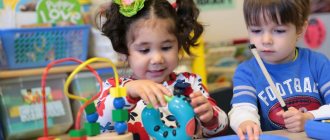Teacher's plan for self-education
. Playing off the plot of your favorite cartoon.Goal : develop the ability to compose verbal descriptions based on the perception of a cartoon.
.
Role-playing game “Kindergarten”
Goal:
to expand and consolidate children’s ideas about the content of the labor actions of kindergarten employees.
Game situations:
- "Morning Reception"
- "Our classes"
- "On a walk",
- "At a music lesson"
- "At a physical education lesson"
- "Medical examination",
- “Lunch in the garden”, etc..
Preliminary work:
1. Observation of the work of the teacher, assistant teacher.
2. Conversation with children about the work of a teacher, assistant teacher, cook, nurse, etc.
3.
Children compose stories on the topic “My best day in kindergarten.”
Showing skits on the theme “Our life in kindergarten.” . Role-playing game "Family"
Goal and objectives:
To encourage children to creatively reproduce family life in games.
Improve the ability to independently create a game environment for a planned plot. Reveal the moral essence of the activities of adults: responsible attitude to one’s responsibilities, mutual assistance Game problem situations:
- “When mom and dad are not at home” (taking care of the younger ones, doing feasible housework),
- “We are preparing for the holiday” (joint activities with family),
- “Welcoming guests” (rules for receiving guests, behavior when visiting),
- “Our day off”, etc.
Preliminary work:
1.
A conversation about the work of parents using illustrated material.
2.
Looking at family photographs.
3.
Children compose stories on the topic “How I live at home.”
. Story-role-playing game “School”
Goal and objectives:
To expand children's knowledge about school.
Help children master expressive means of role implementation (intonation, facial expressions, gestures). Create your own gaming environment for your intended purpose. To contribute to the formation of the ability to creatively develop game plots. Help children learn some moral standards. Game actions:
The teacher conducts lessons, students answer questions, tell stories, count,
etc. Thematic role-playing game “Library”
Goal and objectives:
to show the social significance of libraries;
expand ideas about library workers, establish rules of behavior in a public place; introduce the rules for using the book; awaken interest and love for books, cultivate a caring attitude towards them. Game actions:
- Librarian accepting applications.
- Working with a card index.
- Issuance of books.
- Reading room.
Preliminary work:
- Excursion to the library followed by conversation.
- Opening of the “Book Workshop” for book repair.
- Exhibition of drawings based on the works read.
. Thematic role-playing game “Hospital”
Goal and objectives:
to arouse children’s interest in the professions of a doctor and nurse;
cultivate a sensitive, attentive attitude towards the patient, kindness, responsiveness, and a culture of communication. Game actions:
- The patient is admitted to the emergency room.
- The nurse registers him and takes him to the room.
- The doctor examines patients, listens carefully to their complaints, asks questions, looks at their throats, etc.
- The nurse gives medications to patients, takes temperatures, gives injections and dressings in the treatment room, treats wounds, etc. Patients are visited by relatives and friends.
Preliminary work:
- Excursion to the medical office.
- Observation of the doctor’s work (listens with a phonendoscope, looks at the throat, asks questions).
- Reading lit. works: Ya. Zabila “Yasochka caught a cold”,
- E. Uspensky “They played at the hospital”,
- Conversation with children about the work of a doctor or nurse.
- Looking at illustrations.
. Thematic role-playing game “Shop”
Goal and objectives:
to arouse children’s interest in the sales profession, to develop skills in a culture of behavior in public places, to cultivate friendly relationships.
Game actions:
- The driver brings the goods by car, the loaders unload them, and the sellers arrange the goods on the shelves.
- The director keeps order in the store.
- Buyers arrive.
- Sellers offer goods, show them, weigh them.
- The buyer pays for the purchase at the cash register and receives a receipt.
- The cashier receives the money, punches the check, gives the buyer change and a check.
Game situations:
“In the grocery store”, “Clothes”, “Products”, “Fabrics”, “Books”, “Sporting goods”.
Preliminary work:
- Reading literary works: B. Voronko “The Tale of Unusual Purchases” and others.
- Ethical conversation about behavior in public places.
- Children compose stories on the topic “What can we do?”, “How to cross the road to get to the store?”, “Where do they sell notebooks and pencils?” etc.
- Making game attributes with children (candies, fruits, vegetables from plasticine)
. Story-role-playing game “Beauty Salon”
Goal and objectives:
to expand and consolidate children’s knowledge about working in the “Beauty Salon”, to create a desire to look beautiful, to cultivate a culture of behavior in public places, respect, and polite treatment of elders and each other.
Roles:
hairdresser, manicurist, beauty salon master, cashier, cleaner, clients.
Game actions:
- The hairdresser washes hair, combs it, makes haircuts, dyes hair.
- The manicurist does a manicure, coats the nails with varnish, and gives recommendations on hand care.
- The beauty salon master does a facial massage, applies cream, paints the eyes, lips, etc.
- The cashier knocks out checks.
- Visitors politely greet the salon employees, consult with the specialists, pay at the cash desk, and thank them for their services.
Preliminary work:
- Children visiting a hairdresser with their parents.
- Children's stories about what they did at the hairdresser.
- A teacher's story about the culture of behavior in public places.
- Looking at an album with hairstyle samples.
- Reviewing catalogs with samples of cosmetic products.
- Making attributes for the game with the involvement of parents (towels, napkins, etc. from colored paper)
Game materials:
mirror, set of combs, scissors, hair dryer, hairspray, cologne, nail polish, children's cosmetics, album with hairstyle samples, bathrobes, towels,
etc. Improvisation CIRCUS! CIRCUS! CIRCUS!
Goal and objectives:
to consolidate children’s ideas about cultural institutions, rules of conduct in public places;
consolidate knowledge about the circus and its workers. Preliminary work:
- Looking at illustrations about the circus.
- Conversation on children's personal impressions of visiting the circus. Reading the works “Girl on a Ball” by V. Dragunsky, “Circus” by S. Marshak,
- Drawing on the theme “Poster for the circus”
. Role-playing game “We are military intelligence officers”
Goal and objectives : develop the theme of paramilitary games, teach children to be attentive, careful, cultivate respect for military professions, a desire to serve in the army, expand children's vocabulary - “reconnaissance”, “scouts”, “sentry”, “security”, “soldiers” "
Game actions:
- The teacher offers to remember films, stories about the life of military intelligence officers, and invites the children to play them.
- Children distribute among themselves the roles of Scouts, Sentinels, Commanders, Security Soldiers, determine goals and objectives, and monitor their implementation.
. Thematic role-playing game “Cosmonauts”
Goal and objectives:
to expand the theme of story games, to introduce the work of astronauts in space, to cultivate courage and endurance, to expand the vocabulary of children: “outer space”, “cosmodrome”, “flight”.
MONITORING
Monitoring of children’s achievements on the topic “Role-playing games as a means of speech development for preschoolers” is carried out according to the following criteria and indicators:
INDICATORS:
- organizes the playing space in accordance with the concept of the game;
- knows how to interact with partners;
- enters into a variety of role-playing dialogues with playing partners;
- the game reflects independently invented events based on everyday, literary and fantasy plots;
- verbally conveys imaginary play actions;
- creates a playful, expressive image.
Teacher self-education 2022
Municipal autonomous preschool educational institution
"Kindergarten No. 58"
Self-education plan for the second youngest teacher
Group No. 4
Topic: “ Children’s experimentation is the path to understanding the world around us.”
Educator: Khorina I.A.
2020 – 2022 academic year
Work plan for self-education of teacher Irina Aleksandrovna Khorina, on the topic: “Children’s experimentation is the path to understanding the world around us.”
The relevance of this topic lies in the fact that the modern theory of teaching and upbringing increasingly turns to the personality of the child, to those internal processes that are formed in him under the influence of activity and communication.
Children are natural explorers, actively collecting information about their surroundings. A tireless thirst for new experiences, curiosity, and a constantly demonstrated desire to experiment and independently seek the truth extend to all areas of activity. This encourages learning to be “problematic”, which should contain elements of children’s independent research. It is necessary to include preschoolers in meaningful activities, during which they themselves would be able to discover all the similarities and differences, giving them the opportunity to acquire knowledge on their own. The formation of cognitive interests is naturally associated with the process of learning, when the main content of a child’s life is a gradual transition from one level of knowledge to another, from one level of mastery of cognitive and practical skills to another, higher one.
As pedagogical research shows, the main problem of education is the loss of attractiveness of the learning process. In the very structure of the educational process there are many objective grounds for the formation of cognitive interests. I was faced with the question of choosing effective forms of interaction. In this regard, the study of children's experimentation is of particular interest. The active introduction of children's experimentation is based on the fact that the child learns everything firmly and for a long time when the child hears, sees and does it himself. Research activities are of great interest to children. Research provides the child with the opportunity to find answers to the questions “how?” and why?". What if you try to ask questions that interest a preschooler to him himself? In order to answer a child, you need to find out what he already knows and what he doesn’t yet know. And not only what, but also how. The more varied and intense the search activity, the more new information the child receives, the faster and more fully he develops.
The Importance of Research Activities
for children can be divided into 4 stages:
1. Enriching the child’s memory, his mental functions are activated, the child begins to understand and remember a lot, and this is naturally stored in his memory.
2. The child’s speech develops; before you say something, you need to figure it out, formulate it, do it.
3. There is an accumulation of a fund of mental techniques - operations; the child thinks during research, when experimenting, he makes some decisions, draws some conclusions for himself.
4. Independence is formed and developed, the ability to transform any objects and phenomena to achieve a certain result.
I aim
My work on this topic is to increase my theoretical level, professional skills and competence.
In my work I set and solve the following tasks:
ü Study the literature on the topic “Children’s experimentation - the path to understanding the world around us.”
ü Creating an interesting subject-development environment for children in the group
;
ü Conducting an open viewing at the preschool educational institution;
ü Speech at the teachers' meeting with consultations for teachers on the topic “Children's experimentation - the path to understanding the world around them”;
Expected results:
enriching the group environment with games and research material for children’s experimentation;
generalization and dissemination of work experience on this topic among colleagues at the final pedagogical council.
Stage I Preparatory | ||
| Deadlines | Form of work | Practical solutions |
| September | 1. Drawing up a work plan for self-education. | Availability of a work plan for self-education |
| 2. Studying literature on the chosen topic of self-education, collecting materials for subsequent work on self-education. | 1. Dybina O. In “Acquaintance with the subject and social environment” For classes with children 3-4 years old Publishing house MOSAIKA-SYNTHESIS Moscow, 2014. 2. Dybina O. V The unknown is nearby: entertaining experiments for preschoolers /Text/ O.V. Dybina, N.P. Rakhmanova, V.V. Shchetinina. –M.: Sphere shopping center, 2005. | |
| October | 1. Consultations for parents “Experimentation is the way to understand the world around us”, “Small steps into a beautiful world!” | Conducting consultations for parents. |
| 2. Questioning parents on the topic “Your attitude to children’s experimentation.” | Conducting a survey of parents. | |
Stage II Main | ||
| November | 1. Formation of a card index | Availability of a card index |
| 2. Continue studying literature on a given topic | 1. Ivanova A.I. Natural science observations and experiments in kindergarten. Plants. /Text/: children's encyclopedia/ A. I. Ivanova – M.: Sphere shopping center, 2004. 2. Ryzhova N. A. Sorceress – Water /Text/ N. A. Ryzhova. – M.: Linka-Press, 1997. | |
| December | 1. Design and replenishment of the young researcher’s corner | Production and replenishment of attributes for children's experimentation (Aprons, gloves, oilcloth, magnifying glass, measures: length, size, volume; set of samples: fabrics, paper, cereals, etc.) Availability of notes and attributes for children's experimentation |
| 2. Conducting experiments with children: - planting onions; - “Find out everything about yourself, balloon”; - “What are the properties of water?”; | Availability of notes and attributes for children's experimentation | |
| January | 1. Workshop for parents “Experimenting at home”; | Availability of notes. Conducting a workshop. |
| 2. Replenishment of the card index | Availability of a card index | |
| 3. Conducting experiments with children: — “The World of Paper”; — “Is it possible to glue paper with water”; - “Is the air ever cold?” | Availability of notes and attributes for children's experimentation | |
| February | 1. Consultation for educators on the topic: “Experimental activities in kindergarten” | Speech at the teachers' council with consultation on the topic: “Experimental activities in kindergarten” |
| 2. Conducting experiments with children: — “In the world of glass”; - “We are magicians.” (identify materials that interact with magnets); - “Why does everything fall to the ground?” | Availability of notes and attributes for children's experimentation | |
| 2. Participation in the competition of children's experimentation corners. | Presentation of the corner | |
| March | 1. Continue studying literature on a given topic. | 1. Poddyakov N.N. Creativity and self-development of preschool children. Conceptual aspect. - Volgograd: Change, 1995. |
| 2. Conducting experiments with children: — “In the world of plastic”; — “Stubborn air”; - “Can animals live in the ground?” | Availability of notes and attributes for children's experimentation | |
Stage III Final (Practical output) | ||
| April May | 1. Conducting an open lesson on the topic: “The amazing properties of air”; | Availability of notes |
| 2. Creative report at the teachers’ council on the topic of self-education “Children’s experimentation - the path to understanding the world around us.” | Availability of report and presentation | |
Bibliography
1. Dybina O. In “Acquaintance with the subject and social environment”
For classes with children 3 - 4 years old Publishing house MOSAIKA-SYNTHESIS Moscow, 2014.
2. Dybina O. In “The unknown is nearby: entertaining experiences and experiences for preschoolers” /Text/ O.V. Dybina, N.P. Rakhmanova, V.V. Shchetinina. –M.: Sphere shopping center, 2005.
3. Ivanova A. I. “Natural scientific observations and experiments in kindergarten.” Plants. /Text/: children's encyclopedia/ A. I. Ivanova – M.: Sphere shopping center, 2004.
4. Ryzhova N. A. “Water Sorceress” /Text/ N. A. Ryzhova. – M.: Linka-Press, 1997.
5. Poddyakov N.N. “Creativity and self-development of preschool children.” Conceptual aspect. - Volgograd: Change, 1995.
How to choose a topic for self-education?
There are only two main criteria:
- requirement to study the topic from the outside (formulated in regulatory documents, in particular, in the Federal State Educational Standard for Preschool Education);
- the work of the teacher himself (lack of experience and knowledge to resolve a particular pedagogical situation).
Thus, before choosing a topic, you need to familiarize yourself with the regulatory framework for preschool education and analyze your own experience.
According to the Federal State Educational Standard, a preschool child develops in the following areas:
- social and communicative;
- educational;
- speech;
- artistic and aesthetic;
- physical.
Self-education
Independence in play is formed gradually, in the process of playful communication with adults, older children, and peers. The development of independence largely depends on how the child’s life is organized in the game. Waiting until he starts playing on his own means deliberately hindering the development of a child’s personality.
One of the important pedagogical conditions that contribute to the development of play in a young child is the selection of games by age. But toys that adults like do not always have educational value for children.
For a game to be interesting for a child (and even for an adult, who will most likely often be his partner) it must be quite understandable and simple and logical according to the rules. The goal of the game should also be simple, understandable and, in principle, achievable. At the same time, it should have a very large, controlled variation in the development of the game’s plot and events. And the player (even a small one) must consciously choose and try to implement some specific option that is advantageous from his point of view. But at the same time, there must be a large element of chance, which makes the game emotional, levels out skill and makes winning possible even for a beginner. After all, if one player always wins and the other loses, the “always losing” player quickly loses the desire to play. And if the “master” is forced to give in all the time, the desire to play with him disappears. Randomness puts players in almost identical conditions. Luck gives chances to everyone, but who managed to realize them? And when a child beats “dad himself” and not because he gave in, but in a “fair battle” - there is no limit to delight.
The developmental side of the game cannot be discounted. A child, playing a board game, even the simplest one, develops his imagination, learns to count quickly, learns to make a decision and begins to understand the relationship between decision-making, his actions and their results. His erroneous actions are obvious to himself and he is already beginning to think about how not to repeat them or avoid them, he understands which situation is bad and which is good. He develops not only tactical, but also strategic thinking.
When purchasing a game, it is important to pay attention not only to novelty, attractiveness, cost, but also to pedagogical expediency. Before you make your next purchase, it's a good idea to talk to your son or daughter about what kind of game he needs. Often girls play only with dolls, so they are often deprived of the joy of playing games that develop ingenuity, resourcefulness, and creativity. Girls play with dolls either alone or only with girls. They have no common interests with boys and there are no prerequisites for the emergence of friendly relationships between children. Boys usually play with cars and children's weapons. Such toys also limit the circle of communication with girls. It’s better, when we are adults, not to divide games into “girls” and “boys”.





